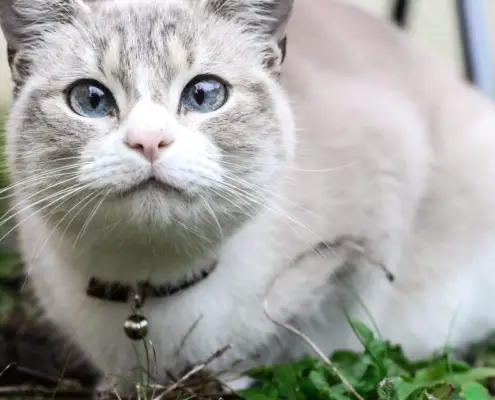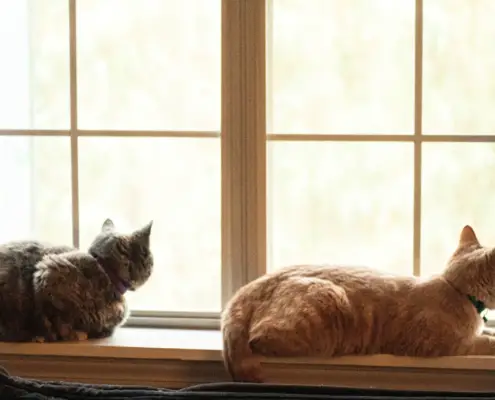
Coughing is a common symptom in humans when we’re feeling under the weather, but have you ever wondered if cats can cough too? In this article, we will delve into the fascinating world of feline respiratory health and explore whether cats can indeed cough. Understanding this aspect of their health is crucial for cat owners to ensure the well-being of their beloved feline friends.
The anatomy of a cat’s respiratory system
To comprehend whether cats can cough, it is essential to have a basic understanding of their respiratory system. Cats, like humans, have a complex system of lungs, bronchi, and trachea that enable them to breathe. However, there are some key differences. Cats have a relatively smaller trachea and narrower bronchi compared to humans, making their respiratory system more susceptible to certain issues such as coughing.
Cats also have a unique structure called the epiglottis, a small flap of tissue located at the base of the tongue, which plays a vital role in preventing food and liquid from entering the windpipe. This structure differs slightly from humans and can contribute to the differences in how cats and humans experience coughing.
Common causes of coughing in cats
There are several potential causes of coughing in cats. One common cause is respiratory infections, such as feline upper respiratory infections or feline viral rhinotracheitis. These infections can lead to inflammation in the respiratory tract, resulting in coughing.
Another frequent culprit is feline asthma, a chronic condition characterized by inflammation and constriction of the airways. Cats with asthma often experience coughing, wheezing, and difficulty breathing. Environmental factors, such as exposure to smoke or dust, can trigger asthma in susceptible cats.
Heartworm disease, although primarily associated with dogs, can also affect cats. When cats develop heartworm disease, the parasites can migrate to the lungs, causing coughing and other respiratory symptoms.
Symptoms to look out for
Identifying the symptoms associated with coughing in cats is crucial for determining the underlying cause and seeking appropriate treatment. Aside from the obvious symptom of coughing itself, cat owners should be aware of other signs that may accompany coughing.
These symptoms can include sneezing, wheezing, difficulty breathing, excessive mucus production, and lethargy. If your cat exhibits any of these symptoms, it is essential to monitor their condition closely and consult with a veterinarian for a thorough evaluation.
Diagnosing coughing in cats
When a cat presents with coughing, a veterinarian will conduct a comprehensive examination to determine the cause. The vet may ask about the cat’s medical history, including any recent respiratory infections or exposure to environmental irritants. They may also perform diagnostic tests such as bloodwork, X-rays, or a bronchoscopy to visualize the airways and identify any abnormalities.
In some cases, the vet may recommend additional tests, such as a fecal examination for parasites or a heartworm antigen test. The results of these tests will help the veterinarian establish an accurate diagnosis and develop an appropriate treatment plan.
Treatment options for coughing cats
The treatment for coughing in cats depends on the underlying cause. If the cat has a respiratory infection, the veterinarian may prescribe antibiotics or antiviral medications to combat the infection and alleviate the coughing symptoms.
For cats with asthma, the treatment approach typically involves managing inflammation and providing bronchodilators to help open up the airways. In severe cases, corticosteroids may be prescribed to reduce inflammation. Environmental modifications, such as minimizing exposure to triggers like smoke or dust, can also help manage feline asthma.
In instances where heartworm disease is the cause of coughing, treatment may involve medications to eliminate the parasites or, in severe cases, surgery to remove them from the lungs. The veterinarian will determine the most appropriate course of action based on the individual cat’s condition.
Preventing coughing in cats
While it’s not always possible to prevent coughing in cats, there are steps that cat owners can take to minimize the risk. Ensuring a clean and healthy environment is essential. Regularly cleaning the litter box, providing fresh water, and maintaining proper ventilation can help reduce respiratory irritants.
Additionally, keeping cats up to date on vaccinations and regular veterinary check-ups can help detect and prevent respiratory infections. Avoiding exposure to smoke and other airborne pollutants can also contribute to a healthier respiratory system in cats.
When to see a veterinarian
If your cat is experiencing persistent or severe coughing, it’s crucial to consult with a veterinarian promptly. Coughing can be a sign of an underlying health issue that requires medical attention. The veterinarian will be able to evaluate your cat’s condition, determine the cause of the coughing, and recommend appropriate treatment options.
Can cats transmit coughs to humans?
One concern that cat owners may have is whether cats can transmit coughs to humans. While cats can develop respiratory infections that may be contagious, it is relatively rare for cats to directly transmit coughs to humans. However, it is always advisable to practice good hygiene and wash hands thoroughly after handling a coughing cat or cleaning their litter box.
Conclusion
Although coughing in cats may not be as common as in humans, it is indeed a possibility. Understanding the causes, symptoms, and treatment options for coughing in cats is essential for cat owners to ensure their feline companions’ well-being. By closely monitoring their cats’ respiratory health, providing a clean environment, and seeking prompt veterinary care when needed, cat owners can help keep their furry friends happy and healthy.
If you enjoyed my article, I would appreciate you sharing it with your network.

Sima Ndlebe
Sima writes for CatBuzz. He is interested in Cats, Health and Fitness, and Entrepreneurship.
Published: 18 November 2023
Related Articles
Disclaimer
The content found on CatBuzz.org is presented on an "as is" basis and is intended for general consumer information and education purposes only. Any utilization of this information is voluntary and solely at the user's own risk.
None of the articles or content should be regarded as, or used in place of, veterinary medical advice, diagnosis, or treatment. The information provided on the website is purely for educational and informational intentions and should not be considered a substitute for professional guidance from a veterinarian or other qualified expert. The articles are designed to inform consumers about veterinary healthcare and medical matters that may impact their cat's daily life. It should be noted that this website and its services do not constitute the practice of any form of veterinary medical advice, diagnosis, or treatment. CatBuzz.org explicitly disclaims any liability for any direct or indirect damages or losses that may arise from the use of or reliance on the information contained within the content.
Consumers must consult a veterinarian, veterinary specialist, or another qualified veterinary healthcare provider when seeking advice regarding their cat's health or medical conditions. It is important not to ignore, avoid, or postpone seeking medical advice from a veterinarian or other qualified veterinary healthcare provider solely based on information obtained from this website. If you believe that your cat may be experiencing a medical issue or condition, it is imperative to promptly contact a qualified veterinary healthcare professional.




